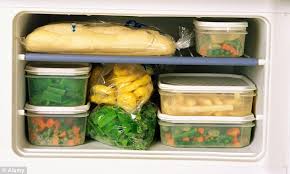There’s a resurgence in preserving foods right now  and there are many ways of doing this. It ranges from basic storage for winter squash and root crops such as onions and potatoes, to freezing, canning, dehydrating, pickling and fermenting. I often take an ingredient and put it by using several techniques; for example I dehydrate plums for compotes and snacking, and make plum jam, as well as freezing them for winter desserts.
and there are many ways of doing this. It ranges from basic storage for winter squash and root crops such as onions and potatoes, to freezing, canning, dehydrating, pickling and fermenting. I often take an ingredient and put it by using several techniques; for example I dehydrate plums for compotes and snacking, and make plum jam, as well as freezing them for winter desserts.
 The freezer presents the least time consuming method of food preservation. Food rotation is important, because the maximum storage time for quality frozen fruit is 12 months, and for frozen vegetables eight months. The maximum amount that should be frozen at once is 3 pounds of food for each cubic foot of freezer space, because freezing small loads of food fast keeps the ice crystals small. This year we had bumper crops of field grown tomatoes, garlic and basil, so I filled my freezer with ziplock bags full of homemade salsa and pesto so that the taste of summer returns in winter!
The freezer presents the least time consuming method of food preservation. Food rotation is important, because the maximum storage time for quality frozen fruit is 12 months, and for frozen vegetables eight months. The maximum amount that should be frozen at once is 3 pounds of food for each cubic foot of freezer space, because freezing small loads of food fast keeps the ice crystals small. This year we had bumper crops of field grown tomatoes, garlic and basil, so I filled my freezer with ziplock bags full of homemade salsa and pesto so that the taste of summer returns in winter!
 A boiling water canner processes high acid foods to 100 C, which destroys moulds and yeasts without compromising the quality of the produce. When correctly processed deadly botulism spores cannot grow in airtight jars, where lids have sealed properly. Forget tasteless store bought tomatoes and put jars of homegrown ones away for the long winter ahead. I simply skin and core them and add salt and lemon juice to the jar before processing in a water canner.
A boiling water canner processes high acid foods to 100 C, which destroys moulds and yeasts without compromising the quality of the produce. When correctly processed deadly botulism spores cannot grow in airtight jars, where lids have sealed properly. Forget tasteless store bought tomatoes and put jars of homegrown ones away for the long winter ahead. I simply skin and core them and add salt and lemon juice to the jar before processing in a water canner.
 Dehydration removes the water content of food by 80 to 90 percent, which inactivates the growth of bacteria, moulds, yeast and other spoilage organisms. I recommend a dehydrator with at least 1000 watts of power to insure proper drying. In general, dried fruits will feel leathery and pliable; dried vegetables will be brittle and tough. This year I have jars full of dried pears, peaches, plums, apples, cherries and tomatoes. My favourite way to get healthy servings of orchard fruit in winter is to start the day with fruit compote combined with yogurt and granola or on top of steaming oatmeal. The secret is to just cover the fruit with boiling water and leave it to rehydrate at room temperature for a few hours or overnight without putting a lid on the bowl. Adding a cinnamon stick, star anise and/or a slice of lemon during soaking makes an even tastier syrup.
Dehydration removes the water content of food by 80 to 90 percent, which inactivates the growth of bacteria, moulds, yeast and other spoilage organisms. I recommend a dehydrator with at least 1000 watts of power to insure proper drying. In general, dried fruits will feel leathery and pliable; dried vegetables will be brittle and tough. This year I have jars full of dried pears, peaches, plums, apples, cherries and tomatoes. My favourite way to get healthy servings of orchard fruit in winter is to start the day with fruit compote combined with yogurt and granola or on top of steaming oatmeal. The secret is to just cover the fruit with boiling water and leave it to rehydrate at room temperature for a few hours or overnight without putting a lid on the bowl. Adding a cinnamon stick, star anise and/or a slice of lemon during soaking makes an even tastier syrup.
 In traditional cultures many foods were preserved by fermentation- grains for miso, beans for tempeh, dairy products as cheese and yogurt, vegetables as sauerkraut or kim chi, and fruit as wine. Ingesting a steady supply of beneficial bacteria keeps your intestinal tract healthy and immune system strong. In order to satisfy my gut micro-biome I have prepared jars of sauerkraut from green cabbage. The process is straightforward- all you need is to scrunch shredded cabbage and sea salt to make a briney liquid, pack it into a jar and leave for a week to ferment. Sauerkraut keeps up to a year when refrigerated. I ferment other vegetables too. There’s a mix of jalapeno peppers, carrots and onions bubbling away on my kitchen counter as we speak.
In traditional cultures many foods were preserved by fermentation- grains for miso, beans for tempeh, dairy products as cheese and yogurt, vegetables as sauerkraut or kim chi, and fruit as wine. Ingesting a steady supply of beneficial bacteria keeps your intestinal tract healthy and immune system strong. In order to satisfy my gut micro-biome I have prepared jars of sauerkraut from green cabbage. The process is straightforward- all you need is to scrunch shredded cabbage and sea salt to make a briney liquid, pack it into a jar and leave for a week to ferment. Sauerkraut keeps up to a year when refrigerated. I ferment other vegetables too. There’s a mix of jalapeno peppers, carrots and onions bubbling away on my kitchen counter as we speak.
 Pickling is another simple way to preserve vegetables, such as beets, green beans, garlic and peppers. This summer produced a bumper crop of field grown eggplants which I am pickling in a large jar with onions, garlic, dill seed, peppercorns and chill peppers. My pickled beets are always praised for deliciousness and all it takes is some white vinegar and sugar. Give it a go as preserving parties are all the rage right now where you can swap your preserves for a wonderful selection of others peoples ‘put aways’. They do say that variety is the spice of life!
Pickling is another simple way to preserve vegetables, such as beets, green beans, garlic and peppers. This summer produced a bumper crop of field grown eggplants which I am pickling in a large jar with onions, garlic, dill seed, peppercorns and chill peppers. My pickled beets are always praised for deliciousness and all it takes is some white vinegar and sugar. Give it a go as preserving parties are all the rage right now where you can swap your preserves for a wonderful selection of others peoples ‘put aways’. They do say that variety is the spice of life!
 Carolyn Herriot is author of The Zero Mile Diet and The Zero Mile Diet Cookbook Available at your local bookstore. She grows IncrEdibles! in Yellow Point.
Carolyn Herriot is author of The Zero Mile Diet and The Zero Mile Diet Cookbook Available at your local bookstore. She grows IncrEdibles! in Yellow Point.
See all articles by Carolyn Herriot



